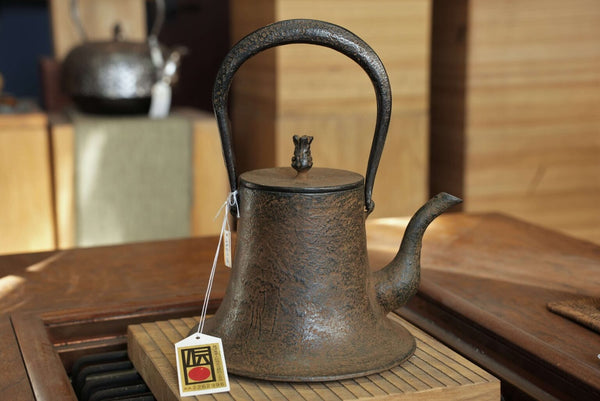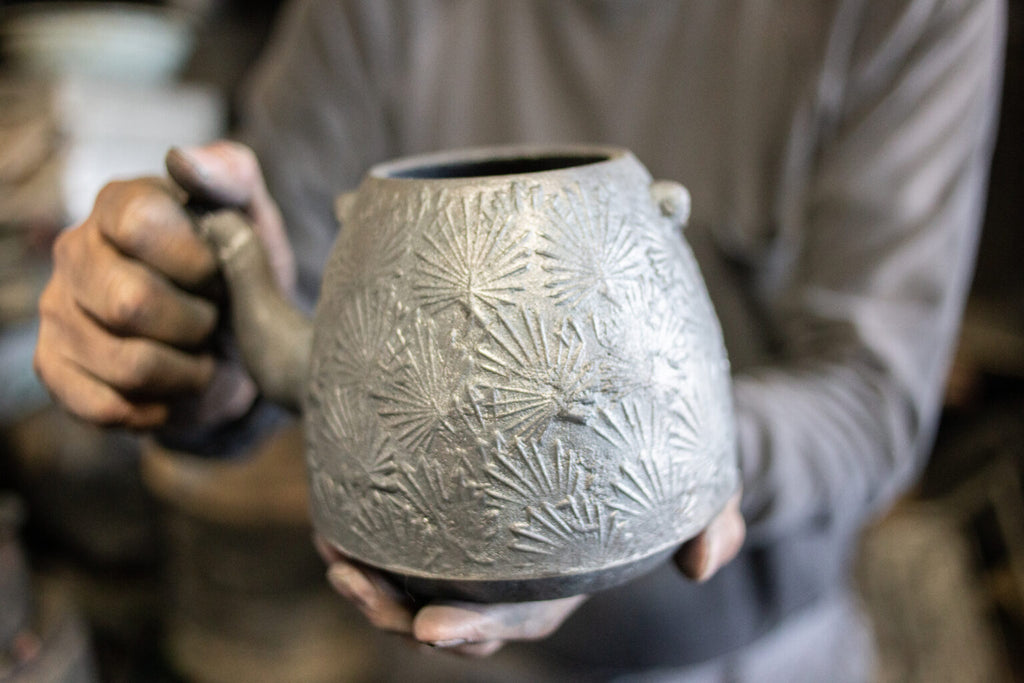The world of Japanese cast iron kettles by traditional craftsman Shingo Kikuchi, who carries on the 400-year-old molding technique of Nambu Tetsubin into the modern era.
While it's important to introduce these products as Nambu ironware, we also aim to spotlight each artisan individually, sharing their journey to becoming craftsmen, their backgrounds, their thoughts and passions in design and production, and their dedication to their craft, including any special techniques they employ.
Today, we introduce Mr. Shingo Kikuchi from Shokado, located very close to OITOMI in Oshu, Iwate Prefecture. Mr. Kikuchi is not only a skilled artisan who has mastered the techniques unique to the production area of traditional crafts, but he has also obtained the national qualification awarded to artisans who have acquired such skills, known as "Dentokogei-shi" (traditional craftsman).
We had the opportunity to speak with Mr. Kikuchi to learn about his motivations behind creating Nambu ironware.

He produces Nambu iron kettles using a technique called "yakigata," where water and clay are mixed with river sand.
The catalyst for becoming a Nambu ironware craftsman
Shingo, who had a penchant for craftsmanship since childhood, recalls witnessing his father crafting Nambu ironware in the workshop next to their home.
"I used to see my father working in the workshop, but I never actually tried my hand at it myself. Since I was never specifically asked to take over the business, I didn't really consider becoming a craftsman during my childhood."
Shingo became a Nambu ironware craftsman at the age of 23. After graduating from a university in the Kanto region, he returned home and resolved to take over the family business.
"I didn't immediately start making Nambu ironware after taking over. It took about 10 years before I felt confident in my work. Understanding the state of molten iron, ensuring the thickness is appropriate – these things vary depending on the temperature and humidity of the day. Without decades of experience, it's difficult to make accurate judgments. So, it took quite some time before I could work independently."
With 45 years of experience as a Nambu ironware craftsman, Shingo has crafted numerous iron kettles based on the solid skills he has acquired over the years.

Manufacturing using the traditional technique of Nambu ironware called "yakigata."
Currently, at Shokado, Mr. Shingo Kikuchi single-handedly manages all stages of iron kettle production, from design to manufacturing. As explained earlier, what Mr. Shingo Kikuchi engages in is the manufacturing process known as "yakigata."Yakigata is one of the production methods of Nambu ironware. It involves mixing river sand with water and clay to create molds. These molds are then pressed with patterns and fired at high temperatures to create casting molds, hence the name "yakigata" (literally "firing mold").
<Process of Yakigata>
- Create a design and make a cross-section of it into a wooden model (mold plate).
- Use the wooden model to create a casting mold by spinning a potter's wheel while mixing sand and clay (mold turning).
- Attach patterns such as arare (hailstone) or sakura (cherry blossom) to the casting mold.
- Dry the casting mold and fire it at around 1200 degrees Celsius.
- Pour iron heated to 1400-1500 degrees Celsius into the casting mold.
- Remove the iron from the casting mold, remove the core, and fire it at 800-900 degrees Celsius (kiln firing).
- Polish the surface, bake the lacquer at 300 degrees Celsius, and apply color.
Compared to the manufacturing method called "nama-gata," which involves making molds only with river sand, the yakigata method requires a longer time for mold shaping and can only cast a few pieces from one mold. Consequently, iron kettles made using the yakigata technique tend to be more expensive. However, each Nambu iron kettle crafted using this traditional method exhibits a delicate and beautiful pattern, reflecting its unique charm that has been cherished since ancient times.

"For iron kettles, I manufacture everything except for the handle (tsuru) myself. During busy times, I might work all day regardless of morning or night, but usually, I work for about 10 hours a day. The pace of production changes depending on the status of orders at the time."
Mr. Shingo Kikuchi mainly produces iron kettles on a made-to-order basis, and it takes approximately two months to complete one kettle. Leveraging the characteristics of yakigata, he meticulously crafts each kettle, adding intricate patterns and details.
*The handle used in iron kettles are not cast using melted iron into molds but forged by hammering iron.There are specialized artisans known as "tsurushi" who craft exclusively these handles.
"The wooden molds that determine the shape of Nambu ironware, most of which I use, were manufactured by myself. For example, the cylindrical-shaped molds were designed by the previous generation and have been passed down. I have probably around 100 different types of molds. I've been continuously producing molds while considering what designs and patterns are demanded by the times. Even for the same 'arare' pattern, there are many variations depending on how it's applied. I've incorporated various directions while listening to customer feedback."

Shingo Kikuchi applies the iconic arare pattern, representative of Nambu iron kettles.
Another characteristic of the iron kettles crafted by Shingo Kikuchi is their color. In addition to the traditional black ironware, he produces many iron kettles with a reddish hue, utilizing rust to create a unique aesthetic.
*When we mention "rust," it refers to the process of applying a coloring solution called "ohaguro," which contains oxidized iron, to finish the surface. This process is referred to as "rusting."
"I choose the color based on the patterns and shapes of the iron kettles. Adjusting the color is a delicate balance between the tea and the ohaguro. More tea results in a stronger black hue, while increasing the ohaguro intensifies the redness. Additionally, the intensity can vary depending on the heat, making it extremely challenging to consistently achieve the same color."

A slightly yellowish tinted MARUGATA UROKO ARARE, 1.1L

A strong reddish hue FUJI STYLE, 0.7L
"Even with those that have a strong reddish hue, as they are used over a long period, the color gradually changes. I believe that along with the passage of time, people can also enjoy the change in appearance."

Conscious of the user's needs. Nambu ironware that is both practical to use and pleasing to the eye
When Shingo Kikuchi creates Nambu ironware, he focuses on aspects such as ensuring the appropriate capacity desired by users, ensuring good pouring when pouring hot water, and other aspects that enhance the usability of the iron kettle. Rather than opting for flashy designs, he prioritizes creating products that can be used in daily life and continue to be used for a long time, pursuing their value as long-lasting items.
Moreover, he highly values considering the customers who are the users.
"I don't prioritize my own desires when creating. Instead, I prioritize making products that will be appreciated and cherished by customers, aiming to create items that bring joy and attachment to them."

The iron kettle ''NAMBU STYLE SYOUMATSUBA" featuring the auspicious pine needle motif boldly arranged, still in the process of production.
Having observed his father at work since childhood, Shingo Kikuchi has served as a craftsman for over 45 years, maintaining his involvement with Nambu ironware for an extensive period. When asked about the charm of Nambu ironware once again, he responds with, "Practical to use, pleasing to the eye."
"In the centuries-long history of Nambu ironware, what remains today is the result of various forms being refined and preserved. While they are undoubtedly beautiful to behold, I also hope they are used and enjoyed as much as possible."
"I don't think I'll be creating entirely new pieces from scratch in the future, but as long as I'm able, I want to continue my work as a craftsman."
Shingo Kikuchi crafts iron kettles with meticulous patterns and beautiful design aesthetics, always prioritizing the needs of the user. I encourage you to experience firsthand his iron kettles, which offer both comfort in use and enduring companionship in daily life.
(December 2023, Shokado, Oshu City, Iwate Prefecture)
 Skip to content
Skip to content
